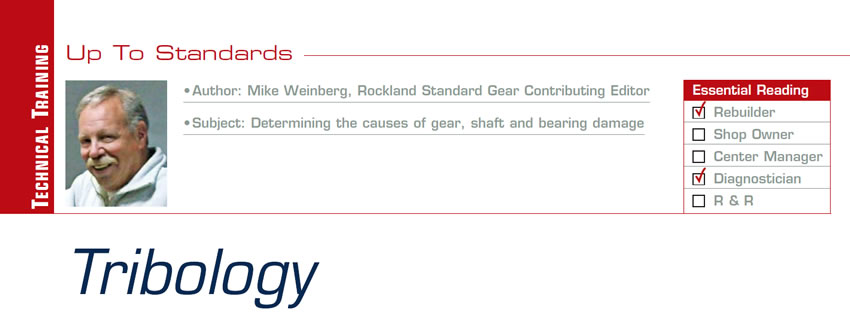
Up to Standards
- Subject: Determining the causes of gear, shaft and bearing damage
- Essential Reading: Rebuilder, Diagnostician
- Author: Mike Weinberg, Contributing Editor, Rockland Standard Gear
Last month we spoke of some of the design and engineering aspects of gear technology. We will advance this discussion to examine the gear and bearing damage, which we see frequently enough. When you look at damaged gears, shafts, bearings etc. are you confident that you can identify the cause of the damage?
The art of rebuilding/repairing gearboxes is based on understanding what caused the original failure and then eliminating the cause of the defect so that it cannot occur again from the same source. Parts fail because of abuse, overloading, defects in material at manufacture, lack of or incorrect lubrication, corrosion, electrolysis, lack of correct preventive maintenance, and gremlins. Tribology is the study of interactive surfaces in relative motion and includes the study of friction, wear and lubrication.
We can break down the various failures in gears and bearings into general categories that are used in ISO designations:
- Fatigue – subsurface and surface
- Wear – abrasive wear, adhesive wear
- Corrosion – caused by moisture or friction
- Electrical erosion – when the rotating assemblies become a ground path
- Plastic deformation (Figure 1) – overload or indentation (Note: Plastic is used to describe motion of the metallic parts in relation to each other and not the material used to make soda bottles)
- Fracture – Forced fracture, fatigue fracture, thermal cracking
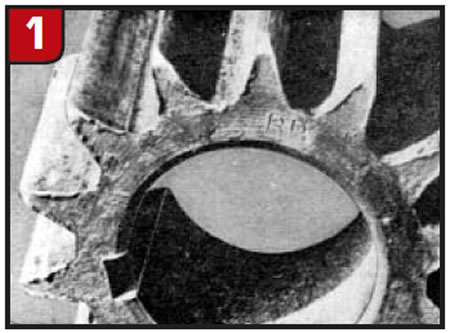
Those who read last month’s article learned about gear-to-gear contact and the design levels used to minimize friction and to reduce heat and the force from the gear pressure angles as they slide against each other while transferring power.
Start with lubrication, which is vital to correct operation and life span of the gear train. The factory specifies a lube on the basis of the desired use of the transmission and vehicle; the synchronizer-ring composition (brass, paper lined, carbon fiber), which determines a necessary coefficient of friction for the oil; a level of how much heat the design will generate; and cost of the product.
The original design in manual transmissions had the gear train being splash lubricated. The lube in the transmission case was thrown about by the motion of the gears and splashed on the gear train, cooling it while absorbing heat and transferring that heat to the sides of the transmission case, which then transferred the heat to the outside air stream passing by the vehicle.
Primary lubricants were usually 90W gear oil, which worked well with larger transmissions that were shifted at relatively low engine speed. 90W oil had one big drawback, and that was too much viscosity for cold-weather conditions. Drivers hated trying to shift the transmission until it got up to operating temperature because it sometimes took both hands on the stick to get into a gear. Chrysler got tired of the complaints and began to specify ATF as the lube fill for its manual transmissions, and that got rid of the cold-shift complaints but raised other issues.
Around the same time the first oil crisis appeared, and weight reduction became the password in vehicle design to get better fuel mileage. That spelled the end of the NP203 and 205 cast-iron transfer cases, and lighter-weight aluminum and magnesium transfer cases that used ATF as lube fill were designed. As carmakers competed for market share, more-efficient higher-revving engines developed and more horsepower came to be. Throw in turbochargers, superchargers, fuel injection, and better design and manufacturing, and transmissions and transfer cases had to handle up to 8,000 rpm in everyday use.
Better synthetic lubricants were developed, and transfer cases and manual transmissions began to be designed with internal lubricant pumps that would pressure-lube the gears and bearings internally through gun-drilled shafts and, at the same time, continue to splash-lube the gear train.
As I said earlier, the use of ATF had some complications, particularly with transfer cases that had no front-axle disconnect. The chain is turning all the time in those transfer cases, and the ATF gets whipped into a mist and migrates out of the transfer case through the vent. It takes a long time and does not really coat the bottom of the vehicle as a big leak would do, but it happens. The manufacturers created a foam patch that was glued over the vent and stopped the oil migration to some degree. At this point I began to advise shops to change the lube fill from ATF to 5W30 motor oil on all non-clutch-driven transfer cases and the problems stopped, as the viscosity of the motor oil would not permit misting.

The lubricant is critical in preventing gear, bearing and shaft failure. It needs to be the correct lubricant in the correct amount. Too little lube and wear increases dramatically and transmission temperatures go high; too much lubricant and transmission temperatures go high because of the windage created by the gears running in too much oil. Too much lube also will create shift problems, as it changes the gear rotational speeds and fouls up the synchronizer timing.
The petroleum in the lube can take around 500°F, but the additive package that makes the oil transmission fluid is going to die at about 300°. Guys who pull big trailers up high mountains need transmission coolers and oil changes around 10,000 miles. Race cars need transmission coolers that pump the oil from the gearbox through an external cooler with fans using an electric pump. The lower you can keep the gearbox temperatures, the longer the oil and the gear train will last. A good range on a manual gearbox is anywhere between 190°F and 250°F.
The various damage that occurs in the gear train usually starts with a failed or misadjusted clutch, bearing failure or driver abuse. A clutch that is not releasing properly will immediately begin to damage the synchronizer components and the engagement teeth on the speed gears. There must be a complete disconnect between the engine and the transmission for proper shifting. A damaged clutch disc also will cause the input to run out of alignment, creating damage at the input gear and the countershaft drive gear.
Bearings fail because of age, as they are rated for millions of revolutions at specific torque loads. Contamination of the fluid will run a lot of particulate matter through the bearings, making them fail quickly. Electrolysis, which occurs when the transmission or transfer case becomes a ground path to the chassis, is a common failure. The vehicle will have electricity flowing through the bearings when parked, and when the vehicle is started up, microscopic spot welds on the rollers or balls will break way under motion only to be redeposited when the vehicle is parked. VW front wheel bearings used to have a very high rate of failure until someone installed a ground strap to get rid of the problem.
When bearings begin to whine the end is near. The bearings hold the shafts in place, set endplay and create the proper distances between the opposing gears. When one or more bearings lose their ability to hold everything on the centerline, big-time failure is the result. If the driver tells you that they had the noise for a while but turned up the radio to keep from hearing it, that is a definition of abuse.
One of the big comeback-causing issues is gear replacement. If any gear shows wear due to running off center because of failed bearings, replace the opposing gear with it. This is 50-plus years of experience talking. If one gear is worn but the other looks good, replace them as a set, because the gear that doesn’t show any wear now has a new pattern worn in it that you can’t see, and there will be a noise problem. The same occurs with a gear that is missing a couple of teeth. The opposing gear looks good, but whatever broke the teeth on the one applied the same pressure on the other, and it will fail later. If you replace damaged gears as a pair the customer pays for it. If you replace one gear of two, you pay for the second one.

Some small pitting on the gear train is acceptable, as it is probably due to some light particulate contamination of the oil. No chips or cracks on the face of a gear tooth should be tolerated, as you cannot tell whether there is any integrity left in the rest of the material.
Spalling is the term used to describe the situation when a larger surface area has broken away from the face of the tooth (Figure 2). This can be caused by incorrect lube, improper hardening of the gears, or high-contact stresses that can be generated by excessive backlash or overloading.
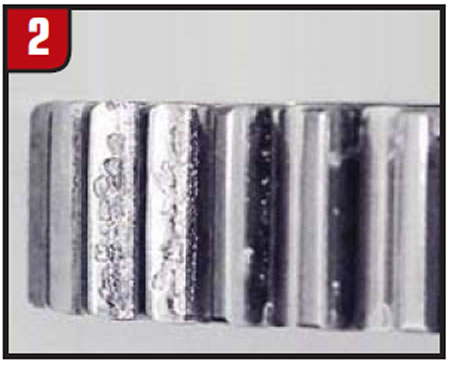
Scoring (Figure 3) is a smearing and rapid removal of material from the tooth surface that occurs when high temperatures and reduced oil film cause the momentary welding of the two surfaces, and the material is torn away as the tooth moves.
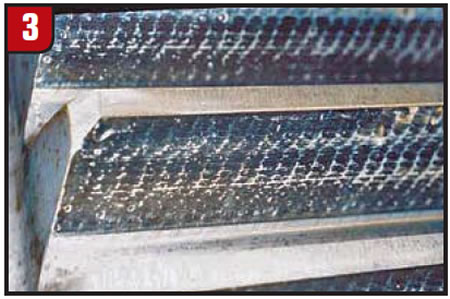
Gear breakage occurs through several different conditions. The first is a foreign object trapped between the meshing teeth. This will break one or more teeth. When replacing a broken gear also replace the mating gear even if it looks OK, because the same stress was placed on both components. A second cause of breakage is driver error. For instance, a driver in a performance situation intends to downshift from 5th to 4th but engages second by mistake. When the clutch is released the entire forward momentum of the vehicle plus engine torque is placed on two or three teeth of second gear.
A similar situation is the driver of a 44-passenger school bus waiting at a traffic signal and then taking off but forgetting that the bus is actually in third gear. This is enough to pull three teeth out of the speed gear or the cluster. Remember that helical-tooth gears can have two, three or four teeth in mesh but no more. A planetary assembly will have three teeth per pinion in mesh and is ever-so-much stronger.

Another cause of breakage is repeated bending stresses put into the gear by more torque load than it can carry. The tiny amount of over-torque to the tooth will eventually cause a crack to begin, usually at the root fillet, and the tooth will break over time (Figure 4).
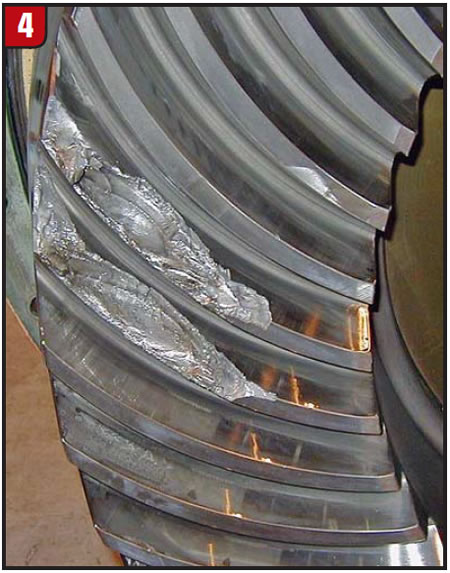
The fourth common cause of breakage is bearing failure that permits the gears to run off the centerline, allowing them to run out of the full depth of mesh.
Shafts are often overlooked in an inspection of the transmission. If you have a lathe or a set of V blocks it is very easy to dial-indicate the shaft for runout. It does not take much runout to create a disaster in short order, as the shaft is now running in sort of a whip and the loads are unequal as it comes to the bent side twice during each rotation. Breaks usually occur where there are built-in stress risers such as snap-ring grooves or the end of the splines, and these are called bending fractures (Figure 5).
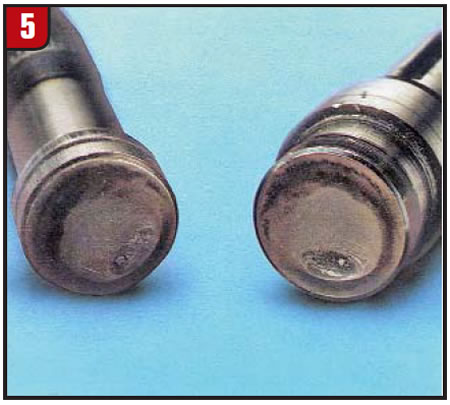
The other issue with shaft breakage is torsional fractures (Figure 6), which result from the shaft locking up during high torque loads because of seized gears, locked driveshaft or differential, or putting 1,000 horsepower through a shaft designed to handle 500. The torsional rotating-shaft damage usually will be an angled, twisted break that may be somewhat polished by the two broken parts rubbing together. Another weak point of shaft design is keyways used to hold gears in place on the shaft. Obviously, one key is never as strong as multiple splines, and keyways have become rare in modern designs.
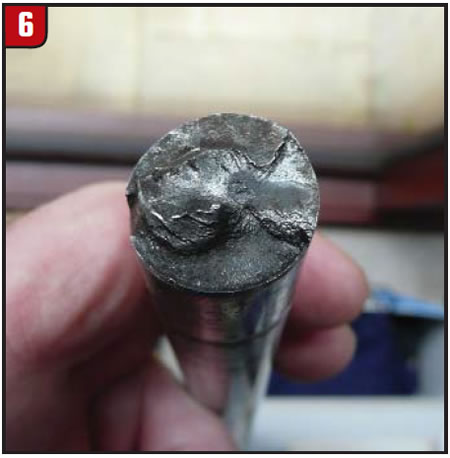
The final issue is bearing failure, which is again a metal-fatigue condition that is caused by improper endplay. Too little endplay will wipe the oil film off the bearings; too much endplay will allow the expansion and contraction of the gear train with changing throttle opening and will eventually beat the bearings to death. Remember that an endplay setting will change as the cases expand during normal operation because of heat.
Another great bearing killer is misalignment due to bent shafts, bent clutch disc, or missing or out-of-line dowel pins on the engine block. Dirty oil or high contaminant levels in the oil will eat the bearings quickly. After a transmission or differential rebuild, bring the customer back in after 500 miles to change the oil. This gets rid of any metallic debris that has come from the new gears lapping into each other.
Low lube, water in the oil (common on 4WD vehicles used off road) or incorrect oil can create problems. Customers won’t always tell you that they drove the Jeep through a three-foot-deep stream and forgot to change the oil. We mentioned electrolysis before, but you can never go wrong by adding a good ground strap from the unit to the chassis.














